- Home
- M. Louisa Locke
Lethal Remedies
Lethal Remedies Read online
Lethal Remedies
A Victorian San Francisco Mystery
M. Louisa Locke
This book is a work of fiction. Names, characters, places, and incidents are either the product of the author's imagination or are used fictitiously, and any resemblance to actual persons, living or dead, business establishments, events, or locales is entirely coincidental.
No part of this book may be reproduced in any form or by any electronic or mechanical means, including information storage and retrieval systems, without written permission from the author, except for the use of brief quotations in a book review.
Copyright © 2020 by Mary Louisa Locke
All rights reserved.
* * *
Cover design © 2020 Michelle Huffaker
All rights reserved.
“Wherever the art of medicine is loved, there is also a love of humanity.”
—Hippocrates
In this time of COVID-19, it seems particularly fitting to dedicate this book to all the medical professionals who have been and are still bravely putting their lives in danger to keep us all safe.
Contents
Chapter 1
Chapter 2
Chapter 3
Chapter 4
Chapter 5
Chapter 6
Chapter 7
Chapter 8
Chapter 9
Chapter 10
Chapter 11
Chapter 12
Chapter 13
Chapter 14
Chapter 15
Chapter 16
Chapter 17
Chapter 18
Chapter 19
Chapter 20
Chapter 21
Chapter 22
Chapter 23
Chapter 24
Chapter 25
Chapter 26
Chapter 27
Chapter 28
Chapter 29
Chapter 30
Chapter 31
Chapter 32
Chapter 33
Chapter 34
Chapter 35
Chapter 36
Chapter 37
Chapter 38
Chapter 39
Chapter 40
Chapter 41
Chapter 42
Chapter 43
Chapter 44
Chapter 45
Chapter 46
Chapter 47
Chapter 48
Chapter 49
Chapter 50
Chapter 51
Chapter 52
Chapter 53
Chapter 54
Epilogue
Author’s Notes
Other Works by Author
About the Author
Acknowledgments
Chapter 1
Wednesday, February 22, 1882
San Francisco, California
* * *
“There’s my big girl,” Annie Dawson said, holding Abigail gently by the arms so the child could sit upright in her lap, facing her. “Look at you, little bright eyes, holding your head up so nicely.”
At nine months, Abigail was a small but sturdy child, her reddish-blonde hair sticking up in riotous curls around her round face, her dark brown eyes alert, with a touch of mischief in them that reminded Annie of her husband, Nate.
She wished he’d come with her. That was one of the reasons she made this late appointment, hoping that her husband would make it home early and she could persuade him to join her. But of course he was working again, late. At least the weather had cooperated, chilly but not windy. And the gentle incline and the broad sidewalks on Taylor and Geary made the three blocks to Dr. Brown’s office and residence an easy walk, even carrying a child.
Annie jiggled her right knee, watching as her daughter grinned, showing two pearly bottom teeth. She turned to the dark-haired, blue-eyed young woman sitting on a chair next to her and said, “I think Dr. Brown is going to be pleased at how much she’s grown since her last check-up, don’t you, Kathleen?”
“Yes, ma’am. She’s at least an inch longer and getting so strong, she’ll be crawling before we know it.”
Annie smiled inwardly at the note of pride in Kathleen’s voice.
When Kathleen Hennessey started working for her, nearly four years ago, the young woman had been an energetic but relatively unskilled scullery maid. Gradually, under the tutelage of Beatrice O’Rourke, Annie’s cook and housekeeper, Kathleen had mastered all the skills necessary to keep Annie’s O’Farrell Street boardinghouse running smoothly. There wasn’t anything, from assisting in the kitchen, ironing the fine linen, serving at table, or keeping the house clean and polished, that the young woman didn’t do to perfection. She’d even become an excellent lady’s maid, with a deft hand at dressing Annie’s hair on the rare occasions she and her husband had a social function to attend. In addition, Kathleen had proven an apt teacher, passing on the skills she’d learned to Tilly, the young Irish girl whom Annie had hired two years ago.
What Annie hadn’t foreseen was how enthusiastically Kathleen would embrace the extra duties that came with Abigail’s birth last May. Frankly, she had expected that Tilly would be the one to step in to help, given that baby-tending was the only skill the girl had brought with her from Ireland. Yet, from the first day, when Annie, exhausted from her long confinement, started to cry when she had difficulty getting the baby’s diapers pinned correctly, it was Kathleen who magically appeared at her side, ready to assist.
That’s why today, when Kathleen asked if she could accompany Annie and Abigail on the visit to the doctor for the child’s check-up, Annie couldn’t refuse her. Mrs. O’Rourke assured her that Tilly was perfectly capable of helping get the meal preparation underway without Kathleen. Nevertheless, if Annie had known Kathleen wanted to come and that Nate wouldn’t make it, she wouldn’t have made the appointment so close to dinner time. And, as often happened, it looked like the doctor was running late and was still engaged with another patient when they arrived. Not the first time this had happened. Well, Annie could send Kathleen back home if the delay was too long.
They had been met at the door by a rather breathless servant, who’d shown them to the former parlor that now acted as a waiting room. Annie knew that this old home, built like her own in the fifties, was the doctor’s residence as well. Dr. Brown once confided to Annie that her husband, a banker, had tried to get her to move up Geary to the more fashionable Western Addition, but she wanted a place that was centrally located for her patients. She and her husband had three children, which, given that they would be home from school and dinner time was approaching, might explain the harried demeanor of the servant.
Suddenly, Annie heard the sound of raised voices coming from the examining room next door.
“Goodness gracious, someone doesn’t sound pleased,” she said to Kathleen. “I’m having trouble picturing anyone getting into an argument with Dr. Brown. She’s always so calm. Nothing ever seems to upset her.”
The doctor’s manner had been so reassuring throughout Annie’s pregnancy, particularly during Abigail’s difficult delivery, when her daughter seemed reluctant to leave the safety of her mother’s womb.
Kathleen whispered, “Ma’am, do you think maybe the doctor had to give someone bad news, and they didn’t take it so well?”
“Oh dear, I hope that isn’t the case.”
The door to the waiting room flew open, startling her daughter. Annie gathered Abigail to her, giving her a comforting pat on her back as she glanced at the tall woman who stood looking back into the examination room. She was well into her middle years and wore a deep purple walking suit in the newest cuirass-style that, in Annie’s opinion, would have looked better on a younger and slimmer woman.
The woman, her voice shar
p with irritation, said, “Charlotte, I certainly hope you will have a more satisfactory explanation at the meeting next month. Otherwise, I can’t promise how I and the other board members will respond.”
When the stranger noticed that she had an audience, she pursed her lips, nodded brusquely to Annie, and pushed rudely past the maid who had reappeared at the door to the waiting room to usher the woman out. In a moment, they heard the front door slam.
“Saints preserve us!” Kathleen whispered. “I wonder what that was all about?”
Just then, Dr. Brown appeared. A short, round-faced woman in her mid-thirties, she smiled pleasantly as if nothing untoward had occurred. She said, “Mrs. Dawson, Miss Kathleen, I apologize for keeping you waiting. Do bring Abigail into the office so I can look her over, although I can see with my own eyes she seems in fine fettle.”
Annie shifted Abigail to her shoulder as she rose, and Kathleen gathered together the paraphernalia that she deemed necessary whenever they took Abigail outside the house.
Passing Dr. Brown, Annie couldn’t help but notice the flush on the good doctor’s cheeks and her rapid breathing.
Hard to believe that a woman like Dr. Brown, who could dissect a cadaver, deliver a baby, and ease a dying patient into the next world, would feel threatened by a society matron with questionable fashion sense.
“If you would hold Abigail facing outward on your lap, that will help,” Dr. Brown said. She put on a starched white apron and rolled back the sleeves of her black silk dress, revealing plump forearms that Annie knew from experience hid surprising strength, certainly enough to support a woman in the throes of birthing pains.
Going over to wash her hands at the stand in the corner of the room that acted as both office and examination room, the doctor said, “It will be easier to do the first part of the examination while she is sitting with you. And if you could take off the booties as well.”
The astringent smell of the soap the doctor used warred with the scent from the vases of flowers scattered around the room. Annie idly wondered what the original owners of the house would have thought if they saw how the current resident was using what had been a formal dining room. A large wooden desk and filing cabinet sat where the sideboard would have been, the former china cabinet now held various strange medical instruments behind its glass doors, and, instead of a table and chairs, a white sheeted examining table stood in the center of the room.
Pulling a chair over so that she was knee-to-knee with Annie, Dr. Brown proceeded to check Abigail’s eyes, ears, and nose, moved her hands gently over the baby’s head, and then had the baby track her finger back and forth, chuckling as Abigail grabbed and held onto her index finger, babbling all the while.
The doctor then took the stethoscope that hung around her neck, put its two ivory-tipped ear pieces into her ears, and lifting up Abigail’s embroidered white gown, placed the wooden funnel against different parts of Abigail’s chest. Familiar with the process, Annie then shifted her daughter slightly, pulling up the rest of her gown so that the doctor could listen to the baby’s lungs from the back.
Annie found her own chest always tightened during this part of the exam. She couldn’t get the memory out of her head of Dr. Sims, who used to examine her mother. He’d used one of the old-fashioned stethoscopes, which was no more than a long single wooden tube. Her mother’s breath would sound so harsh, and Dr. Sims would frown then shake his head sadly. There had been something seriously wrong with her mother’s heart…causing her lungs to fill up. She had died when Annie was only twelve, and Annie worried that there was some similar defect that might crop up in her daughter’s heart.
Dr. Brown leaned back and returned the stethoscope to a large pocket in her apron, saying, “Her heart and lungs sound perfectly fine. Now, Mrs. Dawson, if you would bring her over to the examining table and take her gown off. And Miss Kathleen, could you poke up that fire a bit? We don’t want her to get chilled.”
Kathleen, who had been hovering behind Annie’s chair, went swiftly over to the fireplace to fulfill the doctor’s request. Once Annie had Abigail’s gown unbuttoned and off, she took her over to the table, where Kathleen clucked with concern when she saw that the baby’s diaper was wet.
Dr. Brown said, “I will take her measurements while you get out a clean diaper, Miss Kathleen. Mrs. Dawson, could you place Abigail on the scale?”
Her daughter looked puzzled to be sitting on something so odd, so Annie initiated a game of patty-cake to distract her. The doctor finished calibrating the scale and announced that Abigail had gained two pounds since the last visit. Next, the doctor had Annie move Abigail back to the table’s padded surface, asking her to straighten her daughter’s legs out as much as possible so she could measure her length. Then, as she quickly examined the baby’s nether regions, the doctor complimented Annie on the lack of any signs of a rash.
By then Abigail was grimacing and flailing her arms, a sure signal she wanted to sit up and would soon express her displeasure, so it was with relief that Annie saw Kathleen was ready to replace the diaper. Annie thought that if anyone should be complimented for the baby’s healthy bottom, it should be Kathleen, who not only did many of the diaper changes, but also was the one who had the unpleasant task of washing all the soiled linens.
Once the diaper was changed, Dr. Brown swept Abigail up in her arms and then lowered her down so that her feet were just touching the table top, letting her stand and push against this surface as if she wanted to bounce. “Everything looks good,” she said, handing Abigail back over to Annie. “You can go ahead and get her dressed and bundled back up.”
No sooner had Annie started to pull the baby’s gown back over Abigail’s head than her daughter began to wail, demonstrating that there was certainly not anything wrong with her lung capacity. Kathleen hurried over to help, putting the baby’s booties on while Annie buttoned the gown.
Raising her voice to be heard, Annie said, “Kathleen, why don’t you go on and take Abigail home? Don’t worry about the bag with the soiled things. I will bring it with me when I come.”
“Are you sure, ma’am? I can probably get her quieted down.”
“I’m sure. I won’t be long, but I had a few questions I wanted to ask Dr. Brown about Abigail’s sleeping and eating habits.”
A few moments later, as she watched Kathleen leave the examining room with Abigail, who was still crying fitfully, Annie told herself that she wasn’t heartless to feel relief for the ensuing silence. And she did have some questions she wanted to ask the doctor, questions that she felt uncomfortable asking in front of her maid.
Dr. Brown, who was standing next to the examination table, taking down some notes, looked up as the door closed behind Kathleen and said, “So, Mrs. Dawson, before we discuss Abigail any further, why don’t you let me give you a brief exam? Because while your daughter is clearly thriving…I’m not so sure you are.”
Chapter 2
“You say you haven’t much appetite? How have you been sleeping?” Dr. Brown asked as Annie slipped off the examination table and began to button up the front of her dress.
“I suppose as well as can be expected. I mean, I’ve always been a light sleeper. Since the baby was born, I tend to wake up three or four times in the night, and I’m not always able to go right back to sleep.”
After shaking out her skirts, Annie sat down on the chair across from Dr. Brown, while the doctor looked briefly at some papers in front of her and made a few notes.
Finally, Dr. Brown said, “Why do you think you are waking up so often? Didn’t you say that Abigail is now sleeping at least seven or more hours at a stretch at night?”
“Yes, but not every night. In addition, at the end of January, while those first two teeth came in, she was pretty fussy. Your suggestion that we start feeding her more solid foods during the day, including some porridge before I put her to bed at six, has helped. I nurse her at eleven, before my husband and I retire. And most nights she doesn’t wake up again until
six or after.”
“So what exactly is the problem?”
Annie suppressed a sigh. “All she has to do is whimper, and I find myself wide awake.”
Dr. Brown raised one eyebrow but said nothing.
“I know, we spoke about this during the last visit. You think I should move her into the nursery.”
“I didn’t say that. I said that I saw no reason why you couldn’t do so, if you wished. Have you started putting her to sleep there during the day?”
“Yes, but at night, I’m afraid I might not hear her right away if she cried, and I don’t want her waking the boarders. During the day, this isn’t a problem. And I swear, Kathleen seems to have some preternatural ability to anticipate when she will be stirring from one of her naps. But at night, it’s different. My sister-in-law is right next door, and Laura has to get up so early to get to the university during the week and to work on Saturday. It wouldn’t be fair to disturb what little rest she gets.”
“And what about your maid, Kathleen? Wasn’t your plan that she start to sleep in the nursery at night?”

 Scholarly Pursuits
Scholarly Pursuits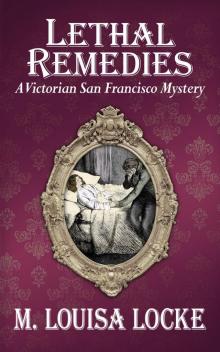 Lethal Remedies
Lethal Remedies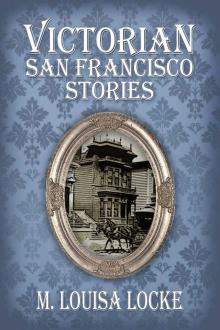 Victorian San Francisco Stories
Victorian San Francisco Stories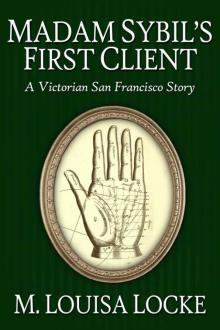 Madam Sibyl's First Client: A Victorian San Francisco Story
Madam Sibyl's First Client: A Victorian San Francisco Story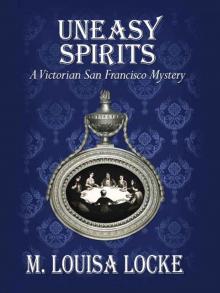 Uneasy Spirits: A Victorian San Francisco Mystery
Uneasy Spirits: A Victorian San Francisco Mystery Dandy Detects: A Victorian San Francisco Story
Dandy Detects: A Victorian San Francisco Story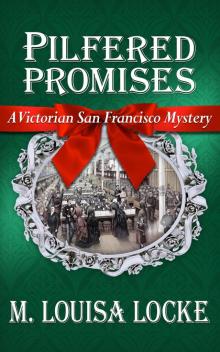 Pilfered Promises
Pilfered Promises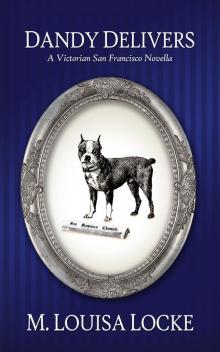 Dandy Delivers
Dandy Delivers Kathleen Catches a Killer
Kathleen Catches a Killer Violet Vanquishes a Villain
Violet Vanquishes a Villain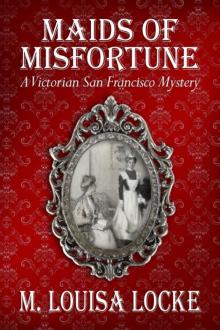 Maids of Misfortune: A Victorian San Francisco Mystery
Maids of Misfortune: A Victorian San Francisco Mystery